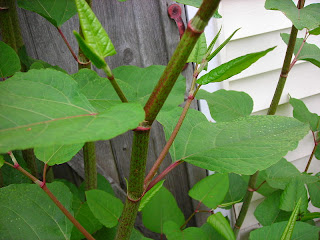Luckily things cleared up for the afternoon because we had a group of high school kids who had been attending this week's New England Student Leadership Conference at Stonehill coming to Sheep Pasture to help with invasive species control. Sheep Pasture has a problem with invasives. Some like honeysuckle were actually planted by Mr. Olmsted while others apparently moved in from other sources. Mrs. Elyse Ames Parker, who donated the property, came from the Rachel Carson generation of environmentalists so she preferred that pesticides and herbicides should be avoided whenever possible. A recent study by the New England Wildflower Society has suggested declaring the invasive war lost and only defending a few areas of importance from the invading hordes.
Our general plan is like King Canute trying to hold back the tide without even the Divinely Granted Majesty of Kingship to help. We cut back growth where we can, then cut the same stuff back a few years later. Roundup is applied only to poison ivy, only in limited areas, and only if mowing fails to remove it. Poison ivy is ubiquitous at Sheep Pasture today perhaps due to the plants preference for increased carbon dioxide.
Yesterday we had 38 dynamic young people from all over New England to help rid our Rhododendron Trail from invasives. The problem was to choose plants that the rookies could recognize and that weren't part of the trail's original planting like barberry. We chose four target plants: glossy buckthorn, Japanese knotweed, Winged Euonymus, and bittersweet. Each are standouts. Buckthorn has an easily recognizable bark (dark background heavily speckled with lighter dots) and right now larger plants are covered with fruit. Here it is:
If you remove the plant now, you should cover the brush pile so birds can't get at the fruit. The kids took care of the major outbreak along the trail and unfortunately discovered dozens of smaller plants along another trail. Luckily buckthorn can be easily pulled up by the roots when young. At home application of Roundup to the cut stem would kill the plant.
Hard to believe but Japanese Knotweed was once planted as an ornamental. Here's what it looks like:
The plant can almost magically regenerate from the root. The best way to get rid of the plant is using herbicide when the plant is in flower, but even that might have to be repeated for several years. We, of course, cut and pulled. Interestingly, saltwater at concentrations similar to seawater have been shown to be effective in killing the plant.
The plant can almost magically regenerate from the root. The best way to get rid of the plant is using herbicide when the plant is in flower, but even that might have to be repeated for several years. We, of course, cut and pulled. Interestingly, saltwater at concentrations similar to seawater have been shown to be effective in killing the plant.
Winged euonymus used to be a popular ornamental in Massachusetts where it's known as Burning Bush for its fall color. Unfortunately it proved to be highly invasive and is now banned for sale here. Branches of this densely branching shrub have a corky wing that makes it easily recognizable. Peg Hoffman and I have been working to remove a large patch of this plant along the road across from the Stable Barn-suddenly you can see into the woods!
As with buckthorn, roundup applied to the cut trunk usually kills the plant.
The last plant we attacked was bittersweet. This heavy twining vine is a tree killer that didn't need an ID as we fought for half an hour trying to free a young hickory from its clutches. There are two species, one native. Phil Benjamin, our forester, recommends removing both species whenever found.
The student leaders worked incredibly hard and loaded our large dump truck twice. To give you an idea of the extent of the invasive problem-the two truck loads were collected in a strip eight feet wide and about a tenth of a mile long.



No comments:
Post a Comment